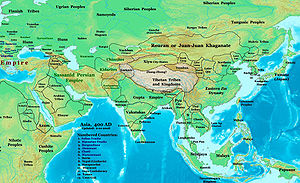
Back Chioniten ALS Xionitlər Azerbaijani Хионити Bulgarian Khionites Catalan Chioniten German Χιονίτες Greek Quionitas Spanish خیونان Persian Xion ID Chioniti Italian

Xionites, Chionites, or Chionitae (Middle Persian: Xiyōn or Hiyōn; Avestan: Xiiaona; Sogdian xwn; Pahlavi Xyōn) were a nomadic people in the Central Asian regions of Transoxiana and Bactria.[1]
The Xionites appear to be synonymous with the Huna peoples of the South Asian regions of classical/medieval India,[2] and possibly also the Huns of European late antiquity, who were in turn connected onomastically to the Xiongnu in Chinese history.[3]
They were first described by the Roman historian, Ammianus Marcellinus, who was in Bactria during 356–357 CE; he described the Chionitæ as living with the Kushans.[4] Ammianus indicates that the Xionites had previously lived in Transoxiana and, after entering Bactria, became vassals of the Kushans, were influenced culturally by them and had adopted the Bactrian language. They had attacked the Sassanid Empire,[1][5] but later (led by a chief named Grumbates), served as mercenaries in the Persian Sassanian army.
Within the Xionites, there seem to have been two main subgroups, which were known in the Iranian languages by names such as Karmir Xyon and Spet Xyon. The prefixes karmir ("red") and speta ("white") likely refer to Central Asian traditions in which particular colours symbolised the cardinal points. The Karmir Xyon were known in European sources as the Kermichiones or "Red Huns", and some scholars have identified them with the Kidarites and/or Alchon. The Spet Xyon or "White Huns" appear to have been the known in South Asia by the cognate name Sveta-huna, and are often identified, controversially, with the Hephtalites.
- ^ a b Felix, Wolfgang. "CHIONITES". Encyclopædia Iranica Online Edition. Retrieved 2012-09-03.
- ^ Hyun Jin Kim, 2013, The Huns, Rome and the Birth of Europe, Cambridge UK/New York, Cambridge University Press, pp. 5, 36–38.
- ^ Schuessler, Axel (2014). "Phonological Notes on Hàn Period Transcriptions of Foreign Names and Words" (PDF). Studies in Chinese and Sino-Tibetan Linguistics: Dialect, Phonology, Transcription and Text. Language and Linguistics Monograph Series. Taipei, Taiwan: Institute of Linguistics, Academia Sinica (53). p. 257, 264. quote: "‘Xiōngnú’ (1-6 匈奴 hɨoŋ-nɑ < *hoŋ-nâ) may well be a regular Hàn period (or even pre-Hàn) rendering of ‘Huns’, i.e. foreign Hŏna or Hŭna, cf. Skt. Hūṇa (but with a long vowel). [...] 1-7 匈奴 Xiōngnú hɨoŋ-nɑ < *hoŋ-nâ 318 B.C.E. [SJ 13; 110:2886; HS 94A:3748] Skt. Hūṇa ‘Huns’."
- ^ Original reports on the "Chionitae" by Ammianus Marcellinus:
Mention with the Euseni/ Cuseni : 16.9.4.
Mention with the Gelani: 17.5.1.
Mention with Shapur II: 18.7.21
Mention at the siege of Amida: 19.2.3 and 19.1.7-19.2.1 - ^ Shapur Shahbazi, A. "SASANIAN DYNASTY". Encyclopædia Iranica Online Edition. Retrieved 2012-09-03.
© MMXXIII Rich X Search. We shall prevail. All rights reserved. Rich X Search